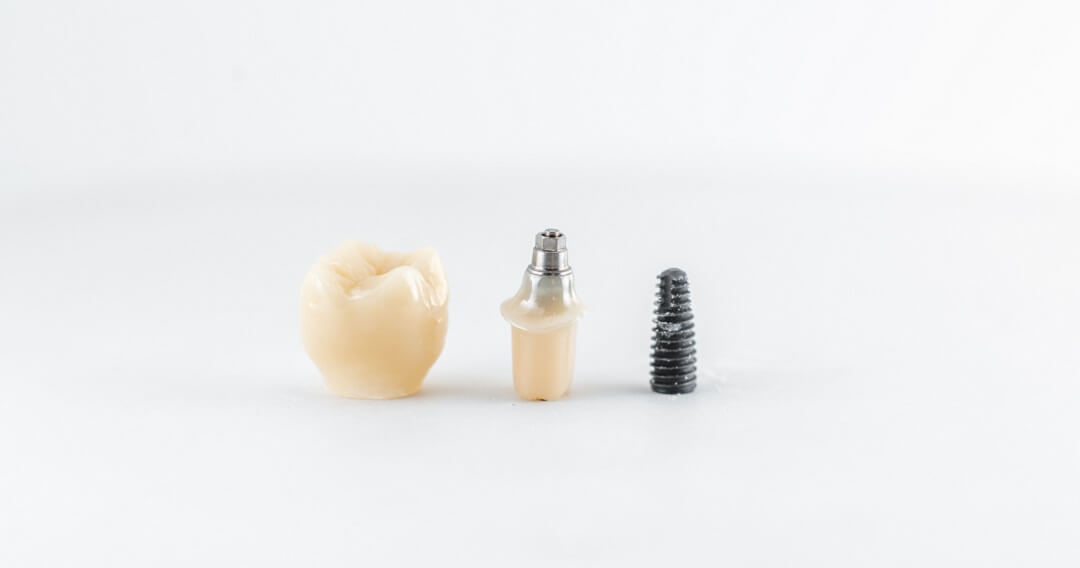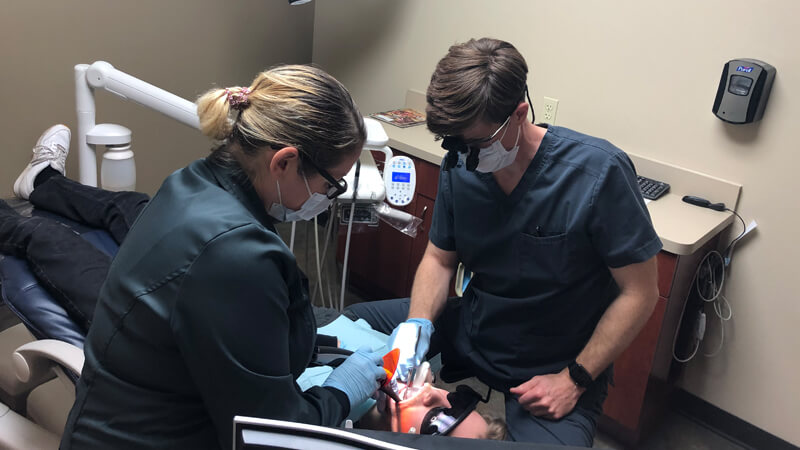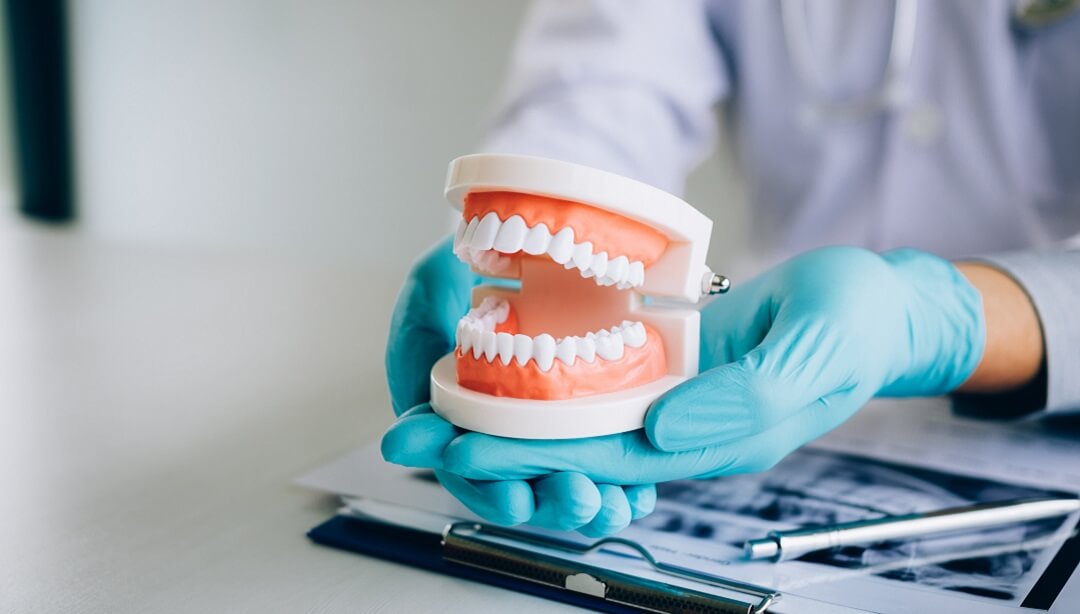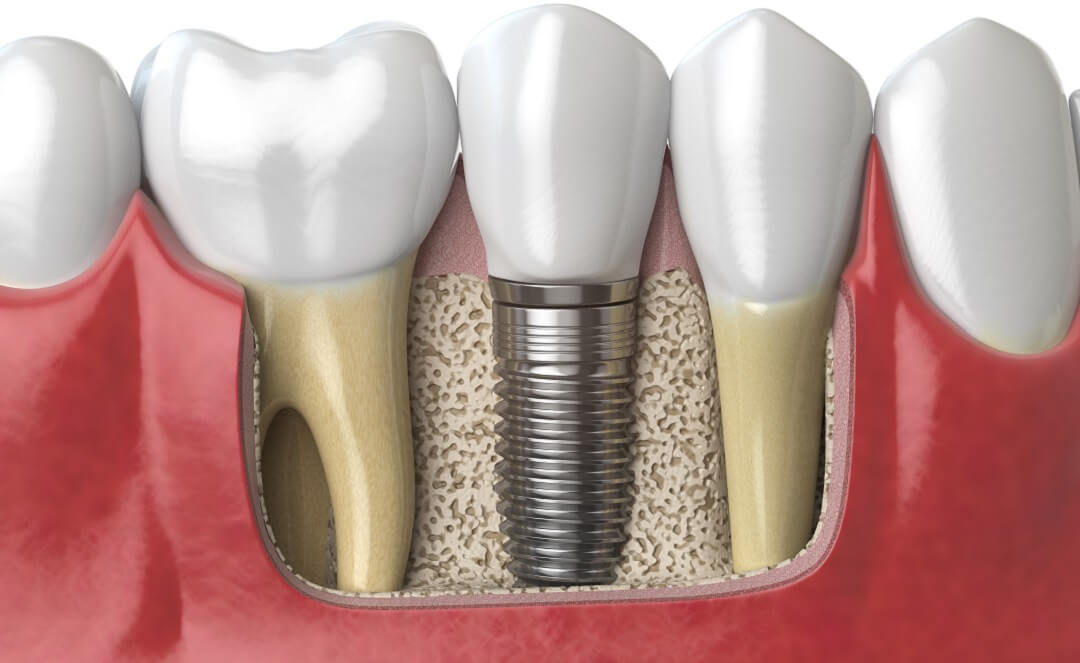We get it. Losing a tooth or multiple teeth can affect your confidence, appearance, and even how you enjoy food. But what if there was a way to restore your smile, confidence, and ability to enjoy life’s simple pleasures?
Dental implants are artificial tooth roots, typically made of titanium, that provide a permanent base for fixed, replacement teeth. Compared to dentures, bridges, and crowns, dental implants are a popular and effective long-term solution for people who suffer from missing teeth, failing teeth, or chronic dental problems.
In this guide, you’ll learn about the types of dental implants, the procedure to get them, their advantages, and the kind of care they require. This information will empower you with the knowledge you need, whether you are considering implants for yourself or are simply curious about the technology.
Key Takeaways
- Dental implants are a long-term solution for missing teeth, mimicking the look and function of natural teeth.
- The procedure involves stages from consultation to final restoration. Bone grafting may be needed if there is insufficient bone growth for successful implant placement.
- Risks like nerve damage or infection exist, but preventative measures during surgery minimize them. Proper oral hygiene post-surgery prevents gum disease or further tooth decay.
- Maintaining implants means good oral hygiene practices and proper diet plays a role in healing and recovery.
What are dental implants?
Dental implants, a cornerstone of implant dentistry, are artificial teeth designed to replace missing teeth. They provide a sturdy and reliable solution for those who have experienced tooth loss due to gum disease, decay, or injury.
Components of dental implants
A typical dental implant involves multiple steps and has three main parts:
-
- Implant: This part is surgically placed into the jawbone by an experienced surgeon. It acts like the root of your natural teeth, providing solid support for the new artificial tooth.
- Abutment: A permanent connector that holds and supports a replacement tooth or set of teeth. Your dentist is the only one who can remove this.
- Crown (or Prosthetic Tooth): This is what you see in your mouth – it’s usually made from porcelain for durability and aesthetics, matching your natural teeth color.
Benefits of Dental Implants
Dental implants have revolutionized implant dentistry, providing a robust and reliable solution for tooth loss. They serve as artificial teeth that replace missing teeth, offering numerous benefits to oral health.
1. Durable and last longer
The dental implants’ longevity and durability make them the preferred choice over traditional dentures or bridges. They can last anywhere from 10-20 years with proper care. The reasons for this include:
-
- Material composition: Dental implants are usually made of titanium, a biocompatible material with impressive strength and durability. It ensures that the body accepts the implant and lasts for an extended period without corroding or breaking down.
- Osseointegration: One of the unique aspects of dental implants is the process of osseointegration. Once an implant is placed in the jawbone, the bone cells grow around and bond with the titanium implant. This integration forms a robust and stable foundation for the prosthetic tooth or teeth.
- Low wear and tear: Unlike natural teeth, the material from which dental implants are made does not decay. Although the crown (the visible part of the tooth replacement) can wear out or break, it can be easily replaced without needing a new implant.
- Strategic placement: The procedure for placing dental implants is strategic, ensuring the implant is positioned in the optimal location in the jawbone for maximum support and sustainability.
- Minimal impact on adjacent teeth: Traditional dental bridges require the grinding down of adjacent teeth, which can weaken them over time. Dental implants do not impact neighboring teeth’ health, contributing to their long-lasting nature.
2. Gives a natural look and comfortable fit
The first benefit of dental implants is their ability to mimic natural teeth. They are designed to look, feel, and function like your real teeth.
Because dental implants are anchored firmly into the jawbone, they function and feel like natural teeth. Patients can speak, eat, and laugh without experiencing discomfort or the fear of the prosthetic coming loose.
3. Improves oral health
Cleaning can be challenging with gaps in the teeth or removable dentures, leading to food entrapment and plaque accumulation.
Dental implants resemble natural teeth and can be cared for similarly—through regular brushing and flossing. This ease of care promotes better oral hygiene practices and reduces the risk of gum disease and tooth decay.
4. Promotes better nutrition
A single missing tooth can dramatically affect your eating habits due to discomfort or difficulty chewing certain foods. With dental implants replacing these gaps, you can enjoy all kinds of food, thus promoting better nutrition than those who wear dentures.
Also, since dental implants restore the mouth’s full function, they ensure proper chewing and food digestion.
5. Protects adjacent teeth
Unlike other options, dental implants do not require the reduction or alteration of adjacent natural teeth.
-
- Eliminates the need for traditional bridges: Traditional dental bridges require the adjacent teeth to be ground down or ‘prepared’ to support the bridge. This process can weaken these supporting teeth and make them more susceptible to decay and other dental problems. Dental implants, on the other hand, are anchored directly into the jawbone and do not rely on neighboring teeth for support, thereby preserving the natural tooth structure.
- Prevents tooth shifting: When there’s a gap due to a missing tooth, the adjacent teeth can gradually shift or drift into the open space. Filling the gap with an implant prevents unwanted shifting, maintaining proper spacing and alignment of all teeth.
- Reduces the load on other teeth: Dental implants distribute biting and chewing forces more evenly across the jaw. This helps reduce the extra load or stress that might be placed on neighboring teeth when one or more teeth are missing.
6. Prevents bone loss
Dental implants are crucial in preventing bone loss often associated with tooth loss. When you lose a tooth, the lack of stimulation by the missing tooth causes the jawbone to gradually deteriorate. This process can lead to further oral health complications if not addressed promptly.
While dental implants can offer a permanent tooth replacement option, they are not suitable for everyone.
Read more about the Disadvantages of Dental Implants here

Types of dental implants
Dental implants have evolved over the years to cater to different patient needs and anatomical variations. The primary types of dental implants include:
Endosteal Implants
The most common type is the endosteal implant. These are typically made from titanium and shaped like small screws placed directly into the jawbone during dental implant surgery. An experienced surgeon will perform damaged tooth removal and jawbone preparation before placing the implant in your mouth.
Subperiosteal Implants
Subperiosteal implants are recommended for patients with minimal bone height or who cannot undergo a bone graft procedure. Unlike endosteal implants, these rest atop it but under your gum tissue
Zygomatic Implants
In cases where there isn’t enough adequate bone in the upper jaw for traditional methods, your dentist might suggest zygomatic implants, as they’re placed in the cheekbone rather than the upper jaw.
Narrow Diameter/Mini Dental Implants (MDIs)
Sometimes referred to as “small” or “narrow” diameter implants (SDIs), mini dental implants serve similar purposes to regular ones but their smaller size allows them to fit into narrower spaces, such as those left behind after single tooth loss.
All-on-4 dental implant surgery
This method involves fitting all replacement teeth onto four strategically positioned posts within your mouth – hence its name, ‘All-on-4’. This option often eliminates the need for additional procedures such as bone grafting because it utilizes available bone efficiently, even if the volume is limited due to gum disease or other factors affecting oral health.

Dental implant surgery procedures
Getting dental implants involves multiple steps, each of which contributes to the overall success of the procedure. Whether you’re replacing a single tooth or several missing teeth, understanding these stages can help ease any anxiety and prepare you for what lies ahead.
Consultation and planning
It begins with an initial consultation at the local dentist’s office. The dentist will check the patient’s dental health using X-rays or 3D images and may also make models of the teeth and jaw to determine if there is adequate bone for implant placement. If not, a required jawbone graft might be necessary.
Bone grafting (if needed)
In some cases where the jawbone isn’t thick enough or too soft, a jawbone graft might be needed before proceeding with the implant dentistry process. This could involve using natural bone from another part of the body or synthetic bone substitute material.
When it comes to bone grafts, there are four main types of bone grafts for different conditions. Learn more about it here: Types of Bone Grafts in Dentistry
Implant Placement
The dental surgeon will place the artificial teeth into the gum during this step. The process also involves removing the damaged tooth and preparing the jawbone for implant insertion. The implants are inserted directly into the bone, creating new roots for your replacement teeth.
Placement of the abutment
An abutment is a small device that connects the artificial teeth or crowns to their respective dental implants and is placed on top of the implant site
Healing and Osseointegration
This stage allows time for healing after placing the implants. Eventually, it will result in osseointegration – the fusion between bones and implants that provides stability similar to natural teeth, thus reducing chances of implant failure considerably over time.
Crown Placement
Once your mouth has healed from placing the abutments – usually about two weeks – it’s time for crown placement. Crowns are essentially artificial teeth designed to mimic your natural teeth closely. They are customized based on shape, size, color, and fit so they blend seamlessly with your existing teeth.

Who is the ideal candidate for dental implants?
Dental implants are an effective solution to replace missing teeth. However, not everyone can be considered a suitable candidate for this procedure. Several factors come into play when determining eligibility.
-
- Necessary oral health requirements: Good oral health is paramount in implant dentistry. Candidates must practice excellent oral hygiene and have healthy gums free from gum disease. Regular dental visits are essential to maintain the overall health of your mouth since it exerts great pressure on the artificial teeth during chewing or biting.
- Bone density considerations: Adequate bone density in your jawbone is crucial for successful dental implant surgery.
- Age and health factors: The ideal candidates for dental implants are adults with fully grown jaws; children’s bones continue growing until late adolescence, making them unsuitable candidates unless deemed otherwise by a professional dentist after careful examination.
Success rate and recovery process
Dental implants have a success rate that often exceeds 95%. Various components can affect the impressive success rate of dental implants, such as a person’s general well-being, dedication to oral hygiene habits, and the dentist’s expertise. Although the success rate is usually high, it’s important to know that minor complications may occur.
The recovery process following dental implant surgery differs for each individual. Generally speaking, patients might experience discomfort regarding swelling or bruising on their face and gums and minor bleeding.
Pain management after surgery
Dentists usually suggest taking over-the-counter pain medications to help manage postoperative pain properly. These are essential in alleviating any immediate discomfort experienced after the procedure.
In addition to adhering strictly to your dentist’s medication instructions, applying an ice pack on your cheek near where you had surgery could relieve swelling and reduce associated pains.
Potential risks and complications
While dental implant surgery is a widely accepted solution for tooth loss, it’s important to be aware of the potential risks and complications that can arise. These include infection, implant failure, sinus issues, and nerve damage.
Infection at the implant site
An infection may occur after dental implant surgery. It typically happens when bacteria enter during or after the procedure. Regular dental visits can help detect infections early on before they become severe.
Dental implant failure
The success rate of dental implants is high, but there could still be cases of implant failure. Factors like inadequate bone support, gum disease, or poor oral health habits can contribute to this issue.
Sinus issues
If an upper jaw dental implant protrudes into one’s sinus cavity because of insufficient bone height or accidental placement, it might lead to persistent sinus problems like pain and congestion.
Nerve damage
Rarely does nerve damage happen from a dental implant procedure. However, when it does occur, it causes pain or numbness in the natural teeth surrounding areas, which requires immediate attention by an experienced surgeon.

Maintaining Your dental implants
Maintaining good oral hygiene practices is non-negotiable if you want long-term success with your new dental implants. Brushing twice daily and flossing once daily helps keep harmful bacteria at bay, thereby reducing the chances of potential infections around your fresh implant site.
How diet affects your dental implants
After surgery, soft foods are highly recommended to facilitate healing. Hard or sticky foods can potentially damage new implants and delay recovery time.
A well-balanced diet plays a significant role, too. Eating food rich in calcium and vitamin D promotes healthy gums around your implant area, reducing the chances of infection post-surgery.
Routine dental visits form a crucial part of maintaining your oral health after getting dental implants. These check-ups provide an opportunity for professional cleaning while also allowing dentists to monitor your implant’s condition closely.

Cost and insurance coverage for dental implants
The financial aspect of the procedure can be significant for many. The price tag varies, influenced by factors such as the number and type of teeth needing replacement – single or multiple teeth.
A ballpark figure for replacing a solitary tooth using an implant might range from $1,000 to $3,000. However, if additional procedures like bone grafts are necessary before the implant placement begins, costs could escalate to approximately $4,500 per replaced tooth.
Dental insurance policies vary widely in their coverage of implants. Some may cover only portions of the procedure, while others might exclude any coverage.
It’s important to communicate with your dentist and insurance company before making decisions. This could help provide clarity about potential out-of-pocket expenses beforehand.
Dental insurance may cover dental implant costs depending on coverage and the reason for needing them. Read our blog: Does Dental Insurance Cover Implants
Financing Options for Dental Implants
Beyond conventional payment methods like cash payments or credit card transactions, several dentists offer financing options. These typically involve monthly installments, making even high-cost treatments more affordable. It is recommended to carefully examine the details before agreeing to any financial arrangements to avoid surprises later.

Dental Implants vs. Other Tooth Replacement Options
When replacing missing teeth, several options are available, including dental implants, dental bridges, dentures, and partial dentures. However, each of these options has its own set of pros and cons.
Dentures & Partial Dentures
Those who wear dentures or partials often complain about discomfort because the mouth exerts great pressure on them while chewing food. They also need regular adjustments due to changes in the natural teeth alignment over time. But they’re less invasive than implants as no surgical procedure is required.
Dental Bridges
A dental bridge replaces a missing tooth by anchoring it onto adjacent natural teeth that have been prepared (often requiring crowns). While this option preserves facial structure well and doesn’t require any bone substitute like in some cases with dental implants, it does put extra strain on supporting teeth that could lead to future problems.

Why choose dental implants over other teeth replacement alternatives?
Dental implants have become a preferred solution for tooth loss, offering a range of benefits that other teeth replacement options, such as removable dentures, often fail to provide. Let’s explore why this is the case.
Advantages to speech clarity and comfort
In terms of speech clarity, dental implants are unparalleled. Since they are securely anchored just like real teeth, there’s no risk of them causing any impediment during conversations – a concern often associated with ill-fitting alternatives.
-
- Mimics natural tooth: The design closely resembles your original tooth structure, aiding in clear articulation without hindrance.
- Firm anchorage: Their secure placement ensures zero slippage, even during extensive talking sessions.
- No discomfort: With precise fitting, you can say goodbye to the unease caused by loose fixtures.
Aesthetics matter, too!
Beyond functionality and comfort, aesthetics also play a crucial role when choosing replacement options. Dental implants win hands down compared to traditional methods due to their ability to mimic a natural-looking smile seamlessly.

Frequently Asked Questions
We have compiled some of the most frequently asked questions about dental implants.
How painful is getting a dental implant?
Dental implants involve minor surgery, but local anesthesia typically minimizes discomfort. Post-procedure pain can be managed effectively with over-the-counter medications.
How long do dental implants last?
Dental implants can last many decades or even a lifetime if properly cared for through good oral hygiene and regular dentist visits.
What are dental implants, and how do they work?
Dental implants are artificial tooth roots that provide a permanent base for fixed replacement teeth. They bond with natural bone to offer strong support for artificial teeth.
What are the three main types of dental implants?
The three main types of dental implants include endosteal (in the bone), subperiosteal (on top of the jawbone), and zygomatic (in the cheekbone).

Your ticket to complete, confident smile!
A long-term solution for missing teeth, dental implants mimic the look and function of natural ones.
They have revolutionized dentistry, offering durable, natural-looking, and highly functional solutions for those with missing teeth. They cater to a wide range of needs, from single tooth loss to multiple, and for those with severe bone loss.
As dental technology advances, the potential for more individualized and efficient treatment options will only grow.
Don’t wait to restore your smile and confidence.
At Soundview Family Dental, we use the latest and best implant technology to provide our patients in Edmonds with a functional and aesthetically pleasing solution for missing teeth.
Contact us today and take the first step towards a healthier, brighter smile. Visit us at our office or call us at (425) 563-6360 now.


